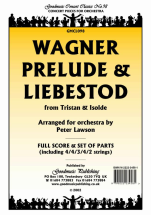Prelude & Liebestod
Buy this item (in stock)
Product ID: GM1 CL098
By Richard Wagner
published: 1859
Publisher:
Goodmusic
Arranger:
Lawson
Series:
Concert Classics
Genre:
Romantic Opera
Line Up:
Symphony Orchestra
Duration:
12:00
Level: 4
Set & Score
This item is in stock
About this item
Wagner's hugely-influential music-drama, Tristan und Isolde, dates from 1859 and was first performed in Munich in 1865. Subsequently, the Prelude to Act I and the concluding from Act III were joined together to bring the music to the concert hall. This arrangement attempts to carry the music one stage further from the domain of the larger professional orchestra with triple woodwind and horns and trumpets crooked in various keys, to the standard orchestra of double woodwind (minus the cor anglais and bass clarinet in A!), Horns in F and trumpets in Bb -and thereby making the work accessible to all. The essential orchestral flavours and colours have been preserved as far as possible, despite considerable and inevitable reorchestration. Tempi markings have been converted into Italian.
Instrumentation
2 Flutes, 2 Oboes, 2 Clarinets in Bb, 2 Bassoons 4 Horns in F, 2 Trumpets in Bb, 3 Trombones, Tuba, Timpani, Harp Strings (Violin 1, Violin 2, Viola, Cello, Bass)
Reviews and rating
No review available, be the first to write one!

Composer
Richard Wagner (1813-1883)
Wilhelm Richard Wagner (22 May 1813 – 13 February 1883) was a German composer, conductor, theatre director and essayist, primarily known for his operas (or "music dramas", as they were later called). Wagner's compositions, particularly those of his later period, are notable for their complex texture, rich harmonies and orchestration, and the elaborate use of leitmotifs: musical themes associated with individual characters, places, ideas or plot elements. Unlike most other opera composers, Wagner wrote both the music and libretto for every one of his stage works.
More info about the composer...



 Click above to view samples
Click above to view samples
